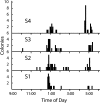Forensic application of microbiological culture analysis to identify mail intentionally contaminated with Bacillus anthracis spores
- PMID: 16885280
- PMCID: PMC1538744
- DOI: 10.1128/AEM.00940-06
Forensic application of microbiological culture analysis to identify mail intentionally contaminated with Bacillus anthracis spores
Abstract
The discovery of a letter intentionally filled with dried Bacillus anthracis spores in the office of a United States senator prompted the collection and quarantine of all mail in congressional buildings. This mail was subsequently searched for additional intentionally contaminated letters. A microbiological sampling strategy was used to locate heavy contamination within the 642 separate plastic bags containing the mail. Swab sampling identified 20 bags for manual and visual examination. Air sampling within the 20 bags indicated that one bag was orders of magnitude more contaminated than all the others. This bag contained a letter addressed to Senator Patrick Leahy that had been loaded with dried B. anthracis spores. Microbiological sampling of compartmentalized batches of mail proved to be efficient and relatively safe. Efficiency was increased by inoculating culture media in the hot zone rather than transferring swab samples to a laboratory for inoculation. All mail sampling was complete within 4 days with minimal contamination of the sampling environment or personnel. However, physically handling the intentionally contaminated letter proved to be exceptionally hazardous, as did sorting of cross-contaminated mail, which resulted in generation of hazardous aerosol and extensive contamination of protective clothing. Nearly 8 x 10(6) CFU was removed from the most highly cross-contaminated piece of mail found. Tracking data indicated that this and other heavily contaminated envelopes had been processed through the same mail sorting equipment as, and within 1 s of, two intentionally contaminated letters.
Figures


Comment in
-
Unsupported conclusions on the Bacillus anthracis spores.Appl Environ Microbiol. 2007 Aug;73(15):5074. doi: 10.1128/AEM.02898-06. Appl Environ Microbiol. 2007. PMID: 17660313 Free PMC article. No abstract available.
Similar articles
-
Bacillus anthracis aerosolization associated with a contaminated mail sorting machine.Emerg Infect Dis. 2002 Oct;8(10):1044-7. doi: 10.3201/eid0810.020356. Emerg Infect Dis. 2002. PMID: 12396913 Free PMC article.
-
Multigeneration Cross-Contamination of Mail with Bacillus anthracis Spores.PLoS One. 2016 Apr 28;11(4):e0152225. doi: 10.1371/journal.pone.0152225. eCollection 2016. PLoS One. 2016. PMID: 27123934 Free PMC article.
-
Unsupported conclusions on the Bacillus anthracis spores.Appl Environ Microbiol. 2007 Aug;73(15):5074. doi: 10.1128/AEM.02898-06. Appl Environ Microbiol. 2007. PMID: 17660313 Free PMC article. No abstract available.
-
Application of the real-time PCR for the detection of airborne microbial pathogens in reference to the anthrax spores.J Microbiol Methods. 2003 May;53(2):141-7. doi: 10.1016/s0167-7012(03)00019-8. J Microbiol Methods. 2003. PMID: 12654485 Review.
-
Responding to the threat of bioterrorism: a microbial ecology perspective--the case of anthrax.Int Microbiol. 2002 Dec;5(4):161-7. doi: 10.1007/s10123-002-0084-x. Epub 2002 Aug 20. Int Microbiol. 2002. PMID: 12497181 Review.
Cited by
-
Genomewide screening for novel genetic variations associated with ciprofloxacin resistance in Bacillus anthracis.Antimicrob Agents Chemother. 2010 Jul;54(7):2787-92. doi: 10.1128/AAC.01405-09. Epub 2010 Apr 12. Antimicrob Agents Chemother. 2010. PMID: 20385868 Free PMC article.
-
Development of an aerosol surface inoculation method for bacillus spores.Appl Environ Microbiol. 2011 Mar;77(5):1638-45. doi: 10.1128/AEM.02237-10. Epub 2010 Dec 30. Appl Environ Microbiol. 2011. PMID: 21193670 Free PMC article.
-
Application of next-generation sequencing technology in forensic science.Genomics Proteomics Bioinformatics. 2014 Oct;12(5):190-7. doi: 10.1016/j.gpb.2014.09.001. Epub 2014 Oct 14. Genomics Proteomics Bioinformatics. 2014. PMID: 25462152 Free PMC article. Review.
-
Rapid Detection of Viable Bacillus anthracis Spores in Environmental Samples by Using Engineered Reporter Phages.Appl Environ Microbiol. 2016 Apr 4;82(8):2380-2387. doi: 10.1128/AEM.03772-15. Print 2016 Apr. Appl Environ Microbiol. 2016. PMID: 26873316 Free PMC article.
-
A multi-function public health surveillance system and the lessons learned in its development: the Alberta Real Time Syndromic Surveillance Net.Can J Public Health. 2010 Nov-Dec;101(6):454-8. doi: 10.1007/BF03403963. Can J Public Health. 2010. PMID: 21370780 Free PMC article.
References
-
- Hinds, W. C. 1999. Aerosol technology: properties, behavior, and measurement of airborne particles, p. 75-110. Wiley-Interscience, New York, N.Y.
-
- Inglesby, I. V., T. O'Toole, D. A. Henderson, J. G. Bartlett, M. S. Ascher, E. Eitzen, A. M. Friedlander, J. Gerberding, J. Hauer, J. Hughes, J. McDade, M. T. Osterholm, G. Parker, T. M. Perl, P. K. Russell, and K. Tonat. 2002. Anthrax as a biological weapon, 2002. Updated recommendations for management. JAMA 287:2236-2252. - PubMed
MeSH terms
Substances
LinkOut - more resources
Full Text Sources
Medical

